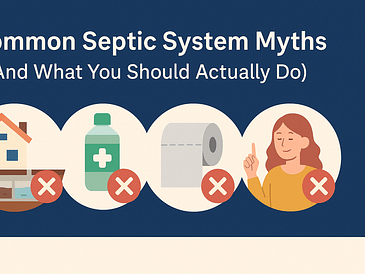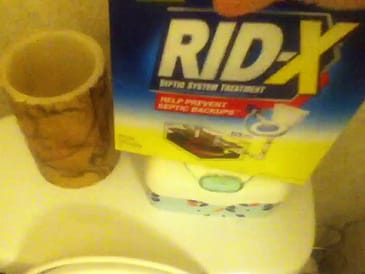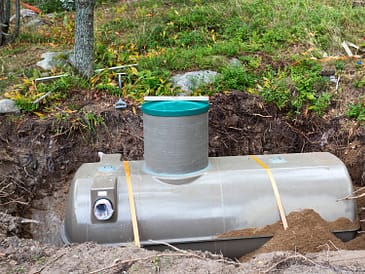
If you own a travel trailer and like to go camping, then a small septic system may be the perfect solution for you. All you need is a little bit of time and some supplies to complete this project.
Generally, septic systems work by collecting waste and sending it to an underground tank. The waste then separates into solid and liquid wastes.
What is a septic system?
A septic system is the part of a home or business that treats wastewater. It uses both physical and biological processes to break down the waste. The septic tank contains bacteria that break down the sludge and FOG (fats, oils and grease). Effluent from the septic system is then sent to a drain field.
If you are going to install a septic system for a travel trailer, you will need to know what kind of tank is best for your needs. There are several types of septic tanks, including plastic and concrete. The material of the tank is also a factor in the installation cost.
The most popular tank material for septic systems is concrete. It is hard wearing and can last for decades. However, it is also expensive.
Another option is a fiberglass tank. These do not rot underground and do not attract algae like concrete. They are lighter than concrete and are less expensive.
You can also use a pressure distribution system for your septic tank, which is more efficient. This is a good option for areas that have higher water tables.
In addition, you can also have a pumping system installed for your septic tank. This allows you to add more fluids and reduce your sewage output.
Getting a small septic system for your RV is not difficult, but you will need to be aware of the different rules and regulations in your area. Some counties and cities may not give you the same exemptions that they do for traditional homes.
One of the most important things to remember when hooking up your septic system is that you should not dump your waste directly into the drains. This is against the law in many states, and it can also lead to heavy fines.
You should connect your septic system to the cleanout pipe that is near the septic tank. You can use sewer fittings to secure the hose and ensure that it fits perfectly.
If you are a newbie to septic systems, it is wise to get help from someone who has experience with them. This will make the job much easier and faster.
Types of septic systems
A septic system for your travel trailer can help you save a lot of money on water costs. If you don’t have a septic tank, you will be forced to use a water source, which can be expensive and pollute the environment.
If you want to avoid this, consider purchasing a small septic system that can be scaled down from the full-scale version of a home’s septic system. This is a good option for RV owners who don’t have much space at their disposal or want to save on water costs.
There are many types of septic systems, and each has its own advantages and disadvantages. Before choosing one, make sure you conduct a thorough research of the different types to determine which is best for your needs.
Some of the most common types of septic systems include above ground septic tanks, soil-based septic tanks, aerobic treatment usage systems and mound septic tanks. Each type can handle different waste types, so it is important to find the right one for your needs.
Septic systems require regular maintenance, including cleaning and emptying. If your septic tank isn’t emptied regularly, it can clog up and cause flooding issues. It can also lead to the sewage backup in your home, which can be costly and stressful.
Generally, you will need to empty your septic tank by connecting your waste hose to the cleanout pipe in your septic tank. This is usually in the ground or in a hole at ground level, so be sure to locate it before starting the emptying process.
You can also connect your septic tank to the sewer line in your RV. This is an affordable way to make sure that you always have a waste connection and will save you a lot of time and hassle in the long run.
If you’re not sure how to connect your RV to the septic tank, talk to a professional. They will be able to advise you on the proper procedure and give you a price estimate for the job.
In addition to the above-mentioned items, you will need a hose and a waste pump. You may also want a clear elbow pipe attachment so you can easily see the waste in your tank.
Installation
If you’re interested in building a small septic system for a travel trailer, the process can be relatively simple. However, you should consider your local laws and zoning regulations before beginning to build.
A septic system is an excellent way to dispose of wastewater from your home. It combines two tanks: one for grey water (the waste from the sinks and showers in your home) and another for black water (the waste from toilets).
Having a septic system means that your waste doesn’t get flushed down your drainpipe, where it would go to a sewer main line under your street. Instead, it goes into the septic tank where bacteria and other organisms break down the waste into useful soil nutrients.
In order to make sure your septic system is effective, it’s important to keep up with the maintenance. Emptying your septic tanks regularly can help prevent buildups of waste and other debris that can damage the tank.
The amount of waste that your septic tank can handle depends on the size of your home and the number of people who live in it. If you’re looking for a system that can handle a heavy load of waste, it’s best to consult with a professional.
This is especially true if you’re planning to use your system for permanent camping. You may also want to look for a system that’s located far away from drinking water sources and other wells, as these can pose a risk of contamination.
A good septic system can be an invaluable tool for long-term camping. It’s worth taking the time to design and install a system that’s right for your needs.
Once you’ve selected a location for your system, it’s time to start putting together the materials that you’ll need. You’ll need a septic tank, an electric pump and a leach line.
You’ll also need ground cloth for the tank and the leach lines. You can buy this at the hardware store or you can use an old shower curtain or another fabric.
After you’ve gathered your supplies, start by digging a hole about 10 feet deep from the top of the RV drain pipe to the bottom of the septic tank. Then, fit the inlet into the tank until it’s snug.
Maintenance
When you travel in your RV, it is important to keep the septic system of the vehicle clean and well maintained. The waste from your toilet, sinks, and baths must be treated properly or your septic system will become compromised.
The first step in keeping your RV septic tank clean is to keep the drains of your toilet and sink free from any trash or other solid materials that could clog your drain pipes. You can use a drain snake or boiling water to clear any clogs in your sewer pipes.
Aside from this, you must also limit the amount of water that is sent down your toilet and sinks to a minimum. This will help your septic system to work more efficiently and avoid the need for costly repairs in the future.
Another way to ensure that your septic tank remains clean is to pump it out regularly by a professional. Typically, this should occur every three to five years.
It is also necessary to inspect your septic tank at least once a year for sludge, scum, or other issues. A septic service professional can provide this inspection and give you a written report on the status of your tank.
If you have a residential septic system, you may want to consider adding insulation to the pipe leading to the soil treatment area. This will help prevent freezing and thawing.
Additionally, you can place a layer of mulch 8 to 12 inches thick over the pipes, tank, and soil treatment system. This can be straw, leaves, hay or other loose material that will stay in place and not compact with time.
Lastly, it is essential to maintain proper temperatures in the tank and soil treatment system. This can be achieved by reducing the water that is sent down the plumbing and making sure that the pipes are insulated.
Regardless of what size your septic system is, it should be inspected on a regular basis by a professional. The average household septic system is pumped out every three to five years, while alternative systems with mechanized parts need to be inspected more often.



